How to become a content creator (in 2025 and beyond)
So, you want to become a content creator.
Where do you even start? Do you need to dance on TikTok? Write long-form articles? Start a podcast? The options seem endless—how are you supposed to make the right decision?
Take a deep breath because there’s no single right way to be a content creator. Whether you want to write, make videos, or talk, content creation is about doing what you do best.
In this article, we’ll share all the goods, including:
- The trends shaping content creation in 2025 and beyond
- What qualifications you need to become a content creator
- The 4 most popular types of content creators
- How much money you can make 🤑
- A step-by-step guide on how to become a content creator
The trends shaping content creation
Creators are more than just a few viral Instagram posts—they’re entrepreneurs building businesses, driving innovation, and creating jobs. Content creation is a thriving $250 billion industry projected to exceed $500 billion by 2027.
And venture capital firms are taking notice. They are pouring millions of dollars into creator-led businesses because they see the obvious: content creation is a legitimate, scalable career with massive earning potential.
Here are the trends we’re seeing in 2025:
- 🚀 AI-powered tools: Content creation is becoming faster and more efficient with AI-driven writing and video editing. More and more content creators are using AI to streamline other parts of their businesses, too—such as notetaking, analytics, and more.
- 📱Short-form video dominance: TikTok, Instagram Reels, and YouTube Shorts continue to be a top way to attract customers.
- 📧 Shift to paid newsletters & private communities: Creators are building deeper connections with engaged audience members through newsletters and IRL events.
What qualifications do you need to be a content creator?
You don’t need a PhD or fancy degree to succeed as a content creator (but if you have one–put it to use, like Ali Abdaal did to help pre-med students study!)
The key ingredients for success are being authentic, focusing on what you’re good at, and building trust with your audience.
Creator case study
Glo Atanmo is a great example of finding success through being yourself, cultivating trust, and embracing your unique expertise. She started pre-med in university to make her parents happy but changed majors to media, design, and photography after listening to her gut. She’s built a nomadic life and business on her terms while cultivating a community (on Circle) where she builds genuine connections with her customers through coaching, courses, and masterminds.
In 2020, Glo earned over $600,000 from digital products alone – so we’d say she’s doing great following her unconventional path.
We’re not telling you this to discourage you from pursuing medicine but to give you permission to get creative, tune into your intuition, and draw outside the lines of your life and your career.
What is a content creator?
A content creator is anyone who produces and shares content—whether it’s video, text, images, or audio—on various digital platforms. While content creators and influencers overlap, their business models and goals can be quite different.
An influencer primarily builds an audience around their personal brand, people follow them for their lifestyle, personality, or aesthetic. Their main source of income often comes from sponsorships, brand deals, and affiliate marketing.
Content creators, on the other hand, often monetize their expertise, creativity, or skills by developing offshoot businesses. This can include selling digital products, launching courses, building paid communities, or generating ad revenue from their own content. While many content creators also partner with brands, their revenue streams are typically more diversified and do not rely solely on sponsorships.
Both influencers and content creators cultivate engaged audiences, but while influencers primarily lend credibility to other brands, creators often build their own brands based on their own unique expertise.
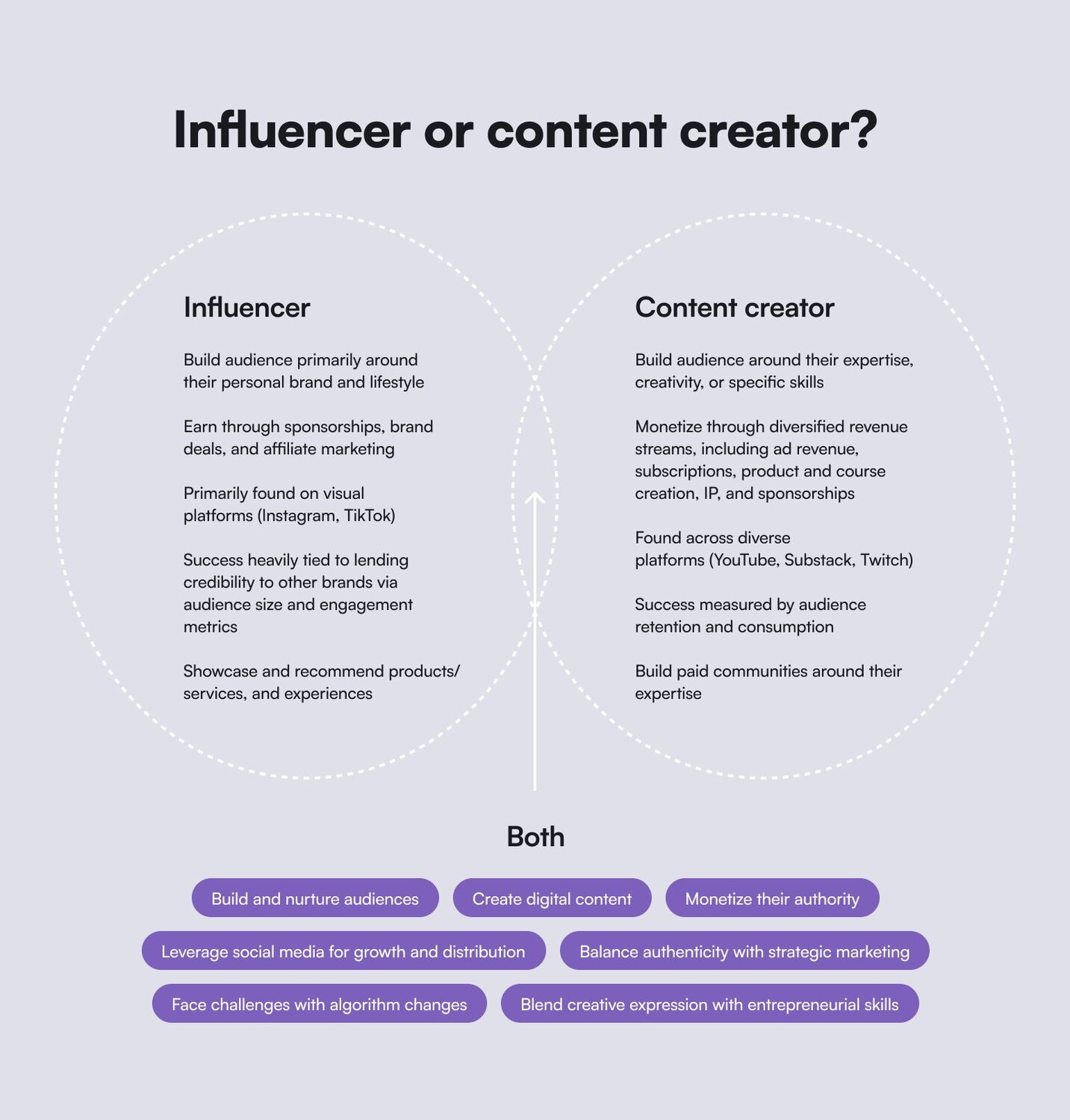
How much money do content creators make?
“Content creator” is an ever-evolving term, with new opportunities constantly emerging (remember Vine?). Depending on your interests and talents, there are many ways to make money and build your brand through content.
There’s also no one-size-fits-all approach to revenue streams. Content creators find their own mix of revenue streams that work for them. By tapping into different income sources, creators build more resilient businesses. Diversifying allows creators to stay flexible, adapt to new opportunities, and build businesses that are less vulnerable to sudden changes in platform policies or trends. For example, while TikTok can be a great way to grow your audience and make money, the recent TikTok ban highlights the importance of not putting all your eggs in one basket.
Let’s explore different types of creators—and the various ways they monetize their work:
Video creators
As mentioned above, most influencers make money through brand partnerships, affiliate marketing, sponsored posts, and product collaborations. On Instagram, micro-influencers (around 10,000 followers) typically earn $100 to $500 per post. Those with over a million followers can receive $50,000 to $100,000 per post. A TikTok influencer's median salary is between $15,000 and $25,000. Plus, features like LIVE Gifts allow fans to send virtual tips that translate into real earnings.
When you move beyond traditional brand sponsorships, video creators can take control of their earnings by launching their own digital products, memberships, or communities—becoming content creators selling their own products and expertise.
Take Angelica Grunewald, a stay-at-home mom who went viral on TikTok after posting some AI automations she created for her husband’s business. She realized she could monetize her automation expertise by building a thriving membership program on Circle. That way, instead of relying solely on social media and brand partnerships for income, she could teach others how to do what she’s doing and grow a community around the trending topic.
If you're looking to grow your following on social media, check out our guide on increasing social media engagement.
On YouTube, creators typically make $1 to $5 per 1,000 views from ad revenue alone. And those who diversify their income streams can earn significantly more. YouTube is the “top platform for generating income in 2025”. It is also the primary income stream for creators who are making over $200,000 annually.
Sean Cannell, the founder of Think Media, built a very-meta multi-million dollar business by teaching others how to succeed on YouTube. Sean monetizes his experience of growing on YouTube through private Circle-powered courses, coaching programs, and digital products, among a mind-blowing 18+ other revenue streams. His community offers members exclusive training, live Q&As, and personalized feedback.
Check out Sean’s playbook on how to succeed on YouTube.
Bloggers & writers
While getting paid for blogging has fallen out of fashion (and gotten much more difficult with the algorithms), paid—and free!—newsletters that lead to other offers, gated content libraries, and long-form writing have never been bigger.
In fact, newsletter are so big, we’re calling them the comeback kids.
Writers who create long-form, high-value content turn their knowledge into income through affiliate marketing, ad revenue, sponsored content, digital products, courses, communities, and premium subscriptions. (All of this is now possible with Circle’s Email Hub!)
Bloggers with 1-3 years of experience earn an average of $80 per month, while those with 3-10 years of experience report earnings from $1,900 to $6,000 per month.
Jay Clouse turned his blog and newsletter into a thriving business by sharing insights on creative entrepreneurship through his newsletter. Over time, he leveraged his newsletter audience to sell digital products, premium memberships, and even an online course. His newsletter now generates over $100,000 per year, proving that long-form content is far from dead.
For today’s creators, blogging isn’t obsolete—it’s just transformed. With the right strategy, a newsletter can be the foundation of a profitable and sustainable business.
Dig deeper into how to repurpose content with Dan Koe — and simplify attracting, engaging, and retaining your audience.
Podcasters
Podcasting offers a unique way to build deep, lasting connections with an audience. Whether you’re discussing business, pop culture, or other niche topics, podcast creators generate income through sponsorships, ads, listener donations, and exclusive content.
Entry-level podcasters might start earning $60 to $250 per month, while experienced podcasters in niche industries earn, on average, $2,600 per month. Those with more listeners or highly engaged listeners can make significantly more. Many podcasters create premium content or offer subscription-based access to bonus episodes.
Learn more about how to monetize a podcast and find the best podcast sponsorships.
Leyla Shams turned her podcast, Chai and Conversation, into a thriving online community using Circle. Now, listeners can engage more deeply, practice their language skills, and access exclusive lessons. Plus, it allows Leyla to maintain a steady income by moving listeners into her online community.
Community educators
Some of the most successful content creators make money by teaching. Creator educators turn their expertise into profitable businesses by offering courses, memberships, exclusive newsletters, consultations, workshops, and digital products like e-books and templates.
A creator educator can earn anywhere from $2,000 to $20,000 per month–but there’s truly no limit to the success of your business. The amount of money they make depends on things like audience size, pricing models, and demand. The demand for high-quality, niche knowledge is rising, and people are willing to pay for direct access to expert insights and structured learning if it’s from creators they trust.
“In 2024, roughly 60% of our revenue came from recurring offers, including membership programs, low-cost and high-value trainings, and payment plans for signature offers like The Growth Collective and The Brand Accelerator. This recurring model has been a game-changer, creating consistent cash flow and allowing us to build more predictable revenue.”
- Julie Solomon, messaging strategist & coach, founder of The Brand Accelerator
Cally Booker is a creator who turned her expertise into a sustainable business. Cally is a handweaver from Dundee, Scotland, known for her vibrant weaving style and dedication to preserving the craft. With over a decade of experience in weaving, she created Weaving Space to share her passion with others and build a community of weavers.
Cally offers online courses, workshops, and personalized mentorship to both beginners and advanced weavers. Using Circle to host her membership community, she provides students with exclusive content, ongoing support, and a space to connect with like-minded individuals.
Cally’s success is a perfect example of how creator educators can leverage niche knowledge and a dedicated community to generate consistent income.
So, is content creation profitable?
Yes, but it requires patience, strategy, and commitment.
In the beginning, earnings can range from $0 to $500 per month. With consistency and growth, mid-tier creators can make between $2,000 and $10,000 per month. Top-tier influencers and creators—especially those with multiple income streams—can earn anywhere from $50,000 to $200,000 per month or more.
The top-earning content creators don’t depend on a single revenue stream or platform—they’re savvy business people as well as content creators–and therefore diversify to ensure long-term financial stability.
“The most innovative creators are seeing their communities as accelerators for multiple revenue streams, not just subscription platforms. They're using their communities to validate new products, gather instant feedback on ideas, and create exclusivity around premium offerings.”
- Rudy Santino, co-founder and chief design officer, Circle
Successful creators often generate income in 4-6 of the following ways:
- Ad revenue (YouTube, TikTok, and blogs)
- Brand sponsorships (Instagram, YouTube, TikTok, and blogs)
- Affiliate marketing (links in videos, blog posts, newsletters, and social media)
- Physical merchandise (hats, bags, shirts, ect.)
- Digital products (eBooks, courses, and workshops)
- Memberships, communities & subscriptions (Circle, Patreon, Substack)
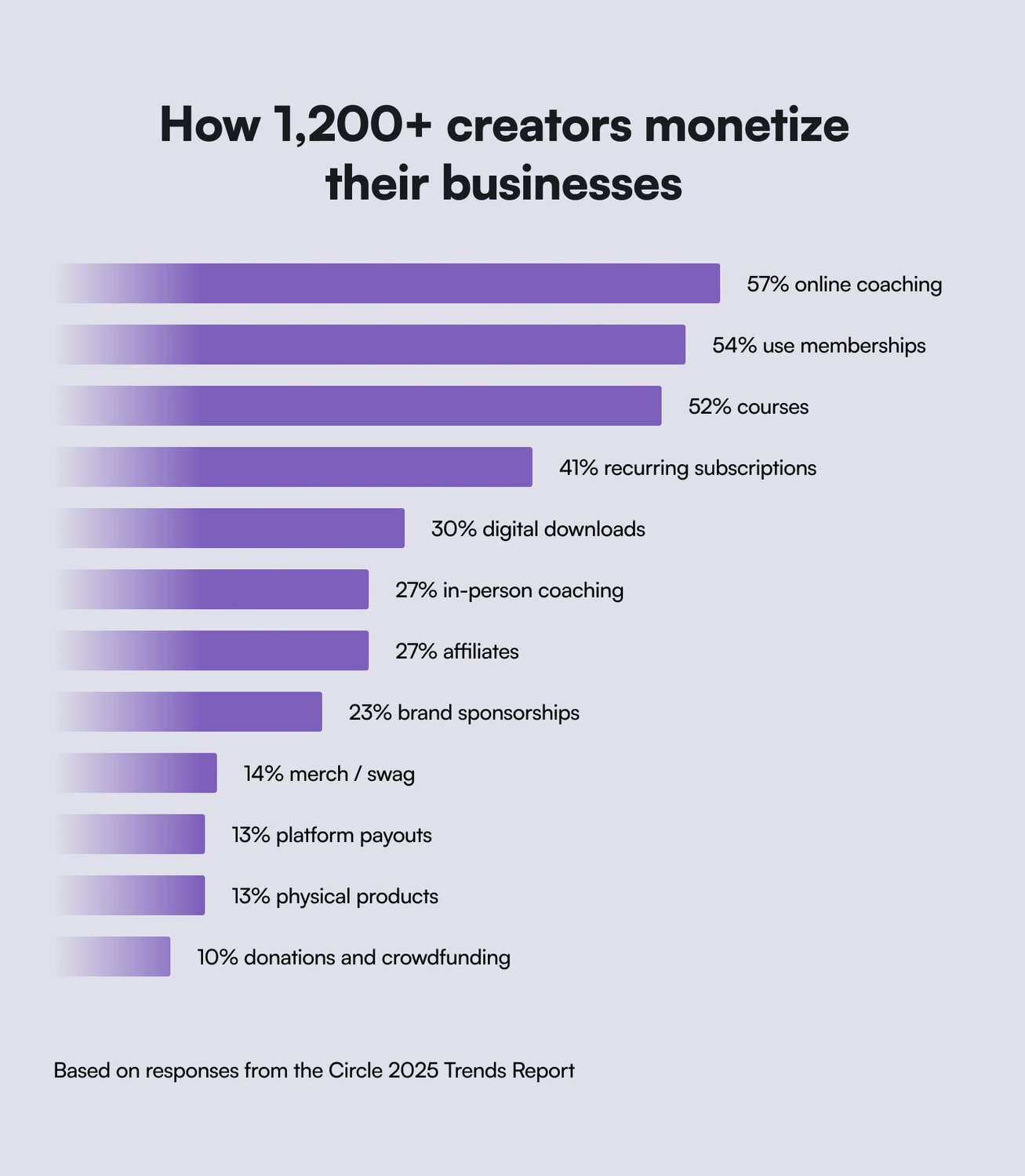
What does it take to be a content creator?
Successful content creators balance creativity, strategy, and consistency. Sid Yadav, co-founder of Circle, says the most successful creators build strong, engaged communities rather than rely solely on algorithms.
“Creators are increasingly recognizing that community is a powerful form of leverage, just like capital, code, or content. A thriving community doesn’t just drive direct monetization through subscriptions; it amplifies everything else they do.
It attracts new members through word of mouth, makes product launches more successful, creates loyalty that strengthens brand partnerships, and fuels recurring revenue streams like memberships, merchandise, and events.”
- Sid Yadav, co-founder and CEO of Circle
You don’t need millions of followers to succeed as a content creator. In fact, engagement and community matter far more than sheer numbers. According to our 2025 Community Trends Report, the most successful creators focus on building loyal, invested audiences—making value, engagement, and member retention their top priorities.
So, what do you actually need to thrive as a content creator?
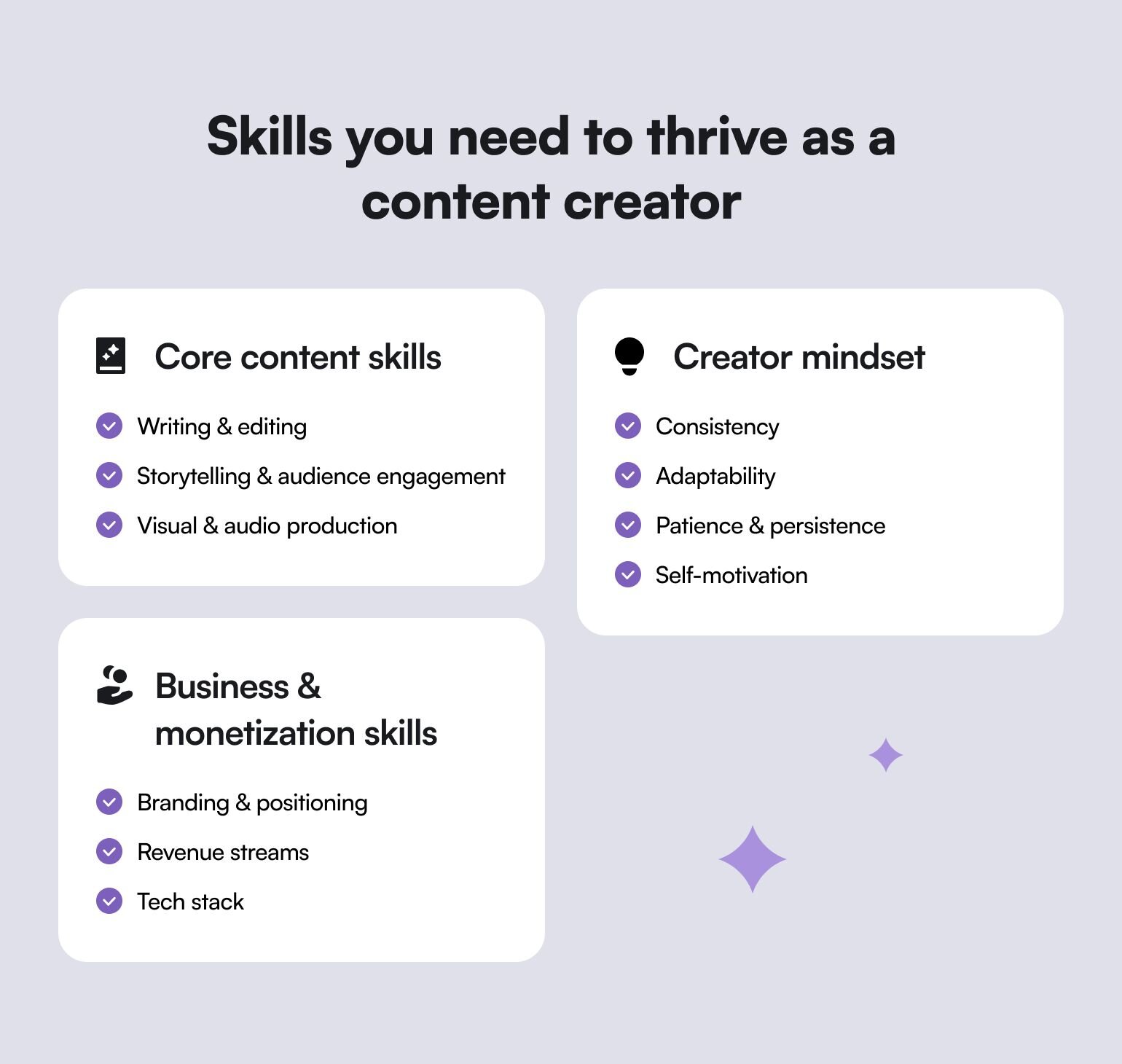
1️⃣ Core content skills:
- ✅ Writing & editing: Well-organized, impactful writing ensures your message is clear, engaging, and easy to understand—whether it's a script, social post, or long-form article.
- ✅ Storytelling & audience engagement: You need to share compelling stories that resonate with your audience.
- ✅ Visual & audio production: Strong visuals and high-quality audio make your content more professional and engaging. Whether it’s designing eye-catching graphics or improving sound quality for podcasts, great production value helps you capture and keep attention.
2️⃣ Creator mindset:
- ✅ Consistency: You need to regularly create and share content to keep your audience engaged and grow your presence. Consistency helps make you recognizable.
- ✅ Adaptability: Stay flexible and open to evolving trends, new platforms, and shifting audience interests.
- ✅ Patience & persistence: Understand that building a successful creator business takes time, experimentation, and resilience.
- ✅ Self-motivation: As a content creator, you’re your own boss—staying disciplined, organized, and driven is key to long-term success.
3️⃣ Business & monetization skills:
- ✅ Branding & positioning: You need to stand out amongst competitors, become known for a certain topic, and build credibility in your area of expertise.
- ✅ Revenue streams: Have a plan on how to monetize through ads, sponsorships, memberships, and digital products.
- ✅ Tech stack: Building the right tech stack is key for any successful content creator. (Hint: Circle is the platform for content creators who want to monetize.)
Step-by-step guide: How to become a content creator
Turning your passion into a thriving content creation career takes more than just hitting “post.” Success comes from crafting a unique brand, connecting with your audience, and staying consistent. Here are the essential steps to help you grow and sustain your presence as a content creator:
Step 1: Find your niche and build your brand
The first part of becoming a content creator is looking within. You need to have a deep understanding of your expertise and the niche you’re in. This will guide your content decisions, help you stand out, and ensure you're creating content from a place of authenticity.
Ask yourself:
- What are you really good at? (Knitting? Marketing? Gardening? SEO optimization?)
- What type of content are you naturally drawn to? (Video? Writing? Audio? Visuals?)
- Who would benefit from your content?
- What problems can you help solve?
See this 8-figure entrepreneur's guide to finding your niche.
Your brand is more than just a logo or name—it’s how you present yourself and your message to the world. Building a strong personal brand helps you stand out, and fosters trust with your audience.
As you create your content, think about:
- Visual identity, voice, and tone: Choose a visual identity that aligns with your values and message. Your logo, color palette, and design style should reflect who you are. Your voice and tone should be consistent—are you casual, educational, personal, or witty? Be authentic.
- Story development: Your story is powerful. Why should people care about your content? What makes your perspective unique? Think about how you can relate your personal experiences to your niche in a way that resonates with your audience.
- Brand consistency: Whether it's the tone of your writing, your visual identity, or the themes you focus on, consistency is key. Ensure that every piece of content aligns with your brand across platforms.
Here's Pat Flynn of SPI giving you a masterclass on brand-building:
🔹 Pro tip: Don’t overthink it—pick a general direction and refine as you go. You can always adjust and tweak as you discover what works best for you and your audience.
Step 2: Choose your platforms
Now that you’ve defined your niche and brand, it’s time to choose the platforms where you’ll share your content. You’ll probably have an idea of where you and your audience hangs out, but it doesn’t hurt to put an intention behind it.
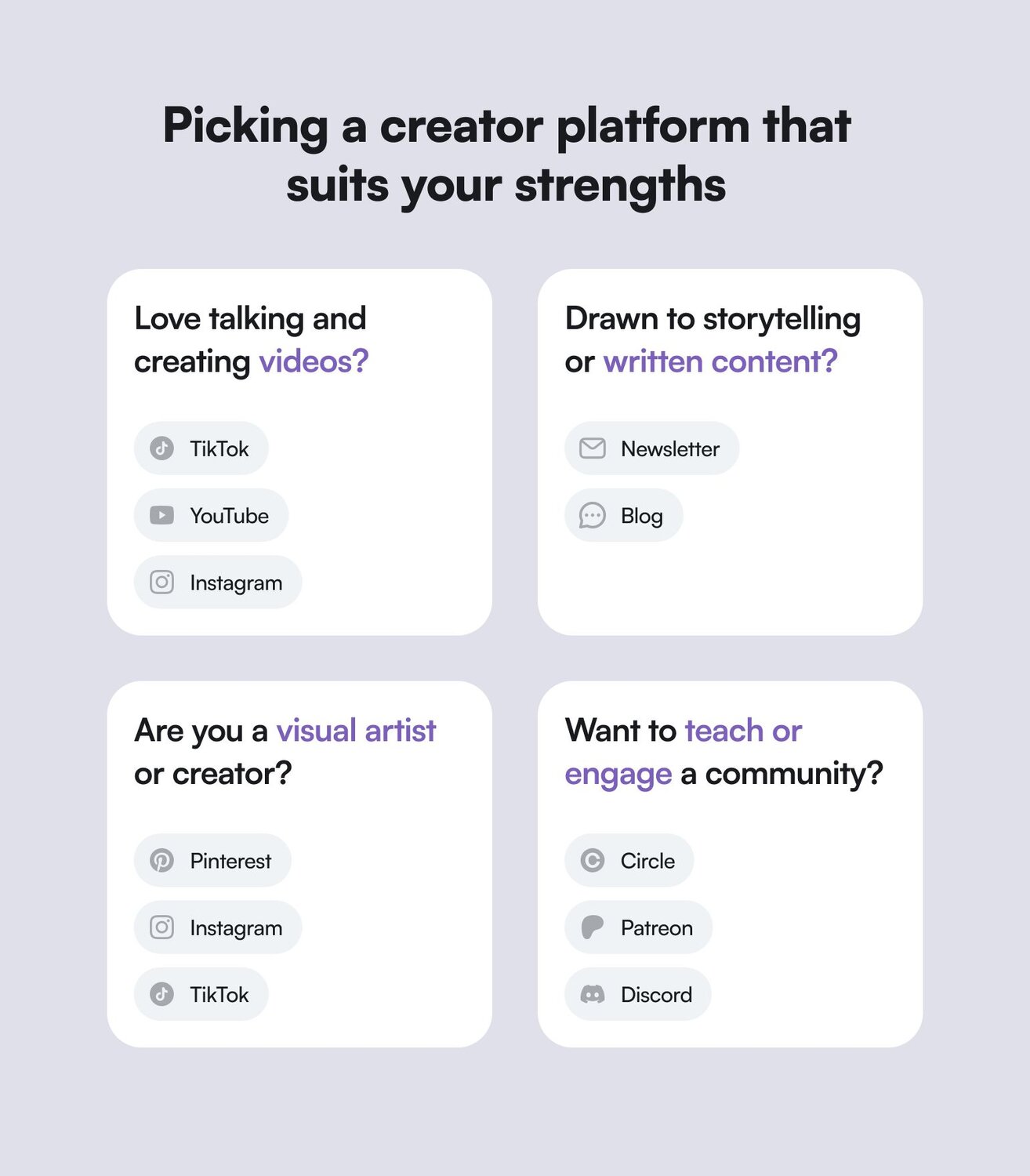
You want to pick a platform that suits your strengths:
- If you love talking and creating videos: Platforms like TikTok, YouTube, and Instagram are great for quick videos or podcasts. Videos and podcasts allow you to showcase your personality, expertise, and storytelling abilities all in one.
- If you're drawn to storytelling or written content: Consider starting a blog or newsletter, which are ideal for more in-depth, thoughtful pieces that allow your personality to shine through words. Writing allows for more nuanced storytelling and lets you take your time crafting your message. It's also an ideal format for sharing personal stories, insights, and expert advice.
- If you're a visual creator or artist: Leverage platforms like Instagram, Pinterest, or TikTok for eye-catching images, infographics, and short-form videos that showcase your creativity. If you're passionate about design, photography, or any other form of visual expression, this type of content allows you to showcase your work in its best light.
- If you want to teach and/or engage with a loyal community: Building a community on Circle, Patreon, or Discord allows for direct interaction, exclusive content, and creating deeper connections with your audience.
Learn more about how to choose the right online community platform for you.
Then, assess each platform's pros and cons. Selecting the right platform is key to getting your content in front of the right people.
You should:
- Evaluate platform strengths: Platforms like TikTok and Instagram are great for quick, engaging content that builds brand awareness. YouTube could offer better monetization, Pinterest can help you reach a broader audience with evergreen visual content, and LinkedIn could be the best space for thought leadership. Understanding these differences will help you make smarter decisions about where to invest your time.
- Assess platform demographics: Consider who uses each platform. Are you targeting younger audiences? Are you looking for a more professional demographic? Understanding platform demographics helps you reach the right audience. (A great way to do this for free is using SparkToro and identifying where your ideal customer already hangs out.)
- Be honest about the time investment: Some platforms require more time and effort to maintain consistency (e.g., YouTube), while others are more casual (e.g., Instagram Stories). Consider how much time you can realistically dedicate to creating content for each platform. Remember that you can repurpose one piece of content you make into a million other pieces of content, too.
🔹 Pro tip: Start with one or two platforms. This lets you refine your content without spreading yourself too thin. Once you have a better grasp of what works best for you, you can expand to other platforms and diversify your offerings.
So, what are the best tools for content creators?
As a content creator, the right tools can make all the difference in helping you create, organize, and share your content efficiently. Whether you're designing visuals, editing videos, or analyzing performance, these tools will help:
🎨 Canva: Easy-to-use design tool for graphics and branding.
📋 Notion: Organize content ideas and plan ahead.
🎬 Descript: Simple and pro-level video editing tools.
📆 Buffer: Schedule content efficiently.
📊 Google Analytics: Track audience insights and growth.
🟠 Circle: Host discussions, offer courses, and create exclusive content all in one place.
And if you want to learn exactly how to build the perfect modern creators’ tech stack—be sure to check out this deep dive on all the tools you’ll ever need.
Step 3: Refine, create, and publish your content
Your brand and content plan will set the foundation for everything you do, shaping how you connect with your audience and establish your presence. Focus on authenticity over perfection, and remember that the best content often evolves over time. Creator Shivani Persad shows how embracing your journey—flaws and all—can be a powerful way to build trust and engagement.
Success in content creation comes from finding a strategy that suits your skills and preferences. But here are tips to refine, create, and publish your content:
- Create content pillars: Identify core topics that you want to focus on—these will be your foundation for creating valuable, consistent content. Instead of just guessing, work backward—analyze your most engaging posts, conversations in your community, and audience feedback to shape your pillars.
- Post consistently: Set a schedule you can stick to. Whether it's a daily Instagram post, weekly blog, or bi-weekly newsletter, consistency is key.
- Engage with your audience: Respond to comments, DMs, and questions. This helps you build a stronger, more loyal community. If interacting with your audience feels like a chore rather than an opportunity, it might be a sign to rethink your approach. The best creators genuinely enjoy these conversations, seeing them as a chance to learn, connect, and create content that truly resonates.
- Batch your content creation: Instead of creating content day by day, dedicate time to creating several pieces at once. This will free up time, ensure you're always ahead of schedule, and help you minimize burnout.
- Repurpose your content: Turn a blog post into a video, create quotes from your podcast, or reuse old content in new ways to keep your audience engaged across platforms.
- Leverage platform best practices: Each platform has unique features that can help boost your content’s reach. Whether it's using hashtags on Instagram or cutting your longer videos into bite-size YouTube Shorts, each platform has its own guidelines for success.
- Optimize your content: Make sure your content is optimized for each platform. Use appropriate titles, descriptions, tags, and thumbnail images to increase visibility.
By developing a clear voice, identifying core content pillars, and leveraging strategic planning techniques, you can build a content creation system that works for you.
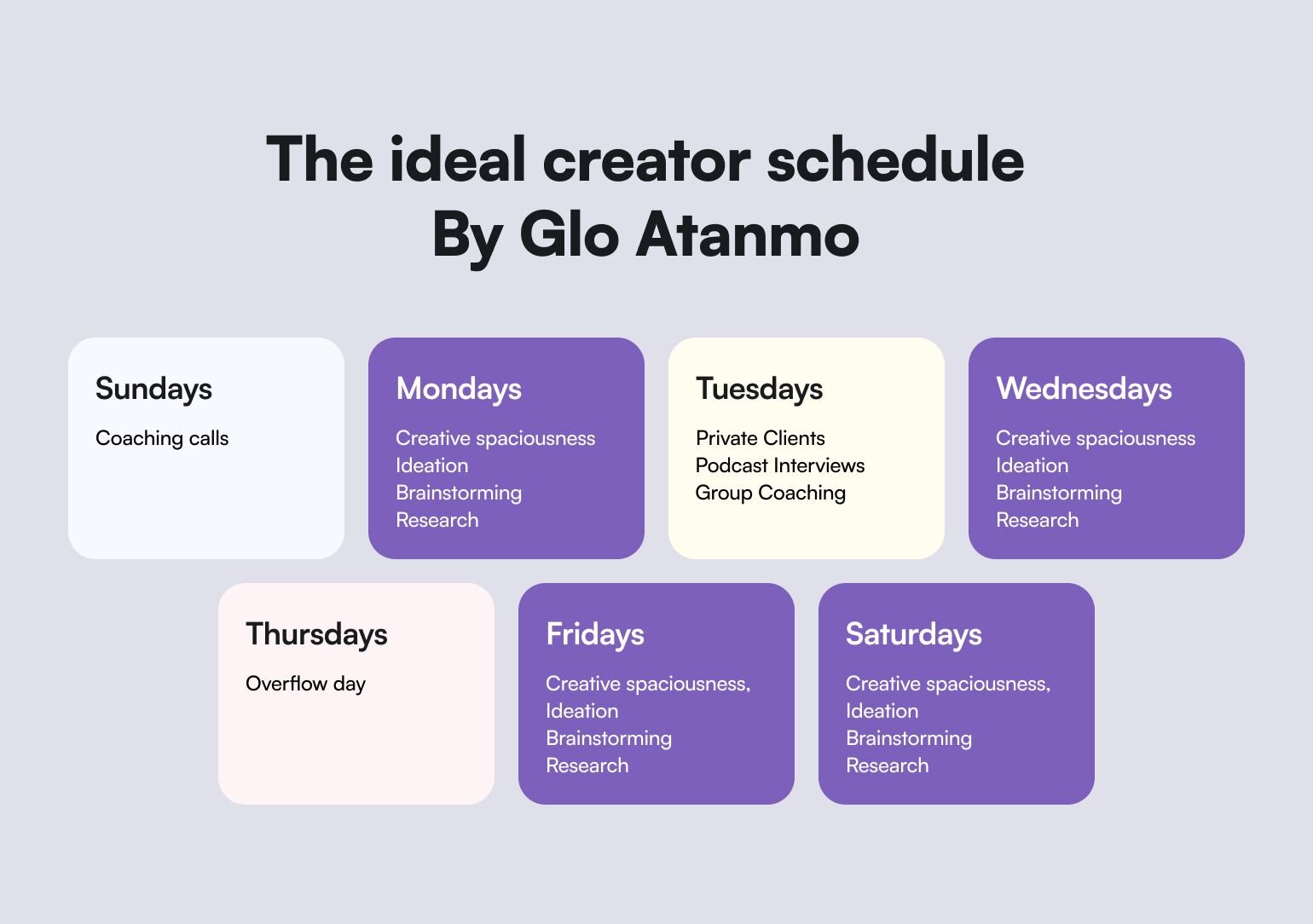
🔹Pro tip: A content calendar can help you stay organized and consistent—but also be sure to leave room for spontaneous content when inspiration strikes.
Step 4: Grow & monetize
With your content live and your audience growing, it’s time to track your progress and refine your strategy based on the data you’ve accumulated.
- Key metrics by platform: Different platforms offer different metrics to track your performance. Pay attention to audience engagement, reach, click-through rates, and follower growth (Just don’t forget to add a point where people convert to paid products, services, or memberships!)
- Growth strategy: Instead of just focusing on growing your numbers, focus on building a sustainable business with solid audience engagement. When you create a "flywheel" of engagement, your content, interaction, and audience growth work in a continuous cycle.
- Data-driven decision-making: Use insights from your analytics to tweak your content and strategy. For example, if a certain type of post performs better than others, make that a focal point in your content strategy.
Here are some ideas on how you could generate income from the content you create:
- Offer memberships or exclusive content: Platforms like Circle allow creators to offer exclusive content or experiences for paid subscribers.
- Collaborate with brands and sponsors: As your audience grows, brands may reach out to partner with you for sponsored content. (But you can also reach out and pitch aligned brands you know your audience would benefit from!)
- Sell digital products or services: If you have expertise, consider creating other products—like eBooks or coaching earlier-stage creators—to generate income.
🔹 Pro tip: Loyal followers matter more than the number of followers. Focus on cultivating a community that trusts you, and monetization will follow.
How to overcome content creation challenges
Still feeling stuck? Here are our answers to the most common questions we see.
| Struggling with | How to beat it: |
|---|---|
| 🙋🏼♀️ "I just don’t know where to start with content creation." | Just start. Pick a topic you love, create something small, and see how it performs–then, refine, adjust, and experiment some more! |
| 🙋🏼♀️ "I don’t have enough time." | Create batch content and schedule posts in advance. Time is a hard one, but consistency is important. |
| 🙋🏼♀️ "I'm concerned about algorithm changes or platform bans." | Diversify across platforms to reduce risk. The TikTok ban in the U.S. hurt creators who relied on it exclusively. Building a presence on multiple platforms can protect you from sudden changes. |
| 🙋🏼♀️ "I'm experiencing burnout." | Schedule regular breaks, set realistic goals, and delegate tasks when possible. Remember, your well-being is essential for sustained creativity |
| 🙋🏼♀️ "I'm facing creative blocks." | Engage in new experiences. Travel, read, or collaborate with others to spark inspiration. Stepping away from your usual routine can lead to fresh ideas. |
| 🙋🏼♀️ "I'm dealing with technical issues." | Invest in reliable tools with tech support (or pay someone to fix em!). Ensure your equipment and software are up to date. |
| 🙋🏼♀️ ”I'm concerned about income instability." | Diversify your revenue streams. In what ways can you create recurring revenue? Perhaps by creating a community with a monthly membership fee? |
As much as we wish it were true, there's no creator (or career path) without trials and tribulations. The key is to stay adaptable, seek support when needed, and continue pursuing your passion with resilience.
Turn your creator path into a career path with Circle
Becoming a content creator isn’t just for professors with fancy degrees or influencers with pretty homes. It’s for anyone with the passion to show up, create, and connect with others. Sometimes you just need to be 2-3 steps in front of people in order to provide value and teach them.
“While social platforms are the perfect stage for finding your tribe, it's the authentic connections and that special sauce of community culture that transforms casual scrollers into ride-or-die community members.”
- Sophie Miller, founder and director at Pretty Little Marketer
Whether you’re just starting or refining your craft, the key is consistency, authenticity, and a willingness to keep learning. Don’t wait for the “perfect” moment—just dive in, embrace the process, and watch your community grow. You’ve got this!
Begin building your community with Circle. Start your 14-day trial today.